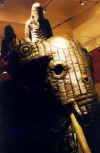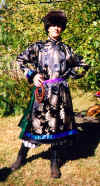 Mangudai!
Mangudai! 
This is a general introduction to Mongols of the 13th century. I may post more
SCA specific information, but things like detailed histories are already well documented,
so why re-invent the wheel. Check out my links for sites
with some really good stuff, and my Mongol clothing section.
Complete Anachronist #54, The Mongols, deals with SCA-related info - by Catriona
Macpherson

"The greatest pleasure is to vanquish your enemies and chase them before you, to rob them of their wealth and see those dear to them bathed in tears, to ride their horses and clasp to your bosom their wives and daughters." - Temujin a.k.a. Chingis Khan
Although often perceived as being brutal barbarians, the Mongol nation was comparatively civilised when formed in the mid 13th century. Before then numerous small clans rode the steppes, defying nature and the more civilised countries surrounding them, while fighting amongst each other. Raiding was common, and blood feuds between clans or families developed over lands, water and horses. Temujin was born to a small clan, and after a hard childhood became head of his clan, he had the vision of unifying the various factions. One cannot be sure how much was vision, and how much was done merely to survive, but the end result was a force never seen before. Nomads had come and gone before, but never before had they swept the world and tried to keep it. The Mongol land Empire was four times as large as Alexander the Great's, twice as big as Rome, and hasn't been exceeded yet.
There came into the world a blue-grey wolf
whose destiny was Heaven’s will.
His wife was a fallow deer.
They travelled across the inland sea
and when they were camped near the source of the Onon River
in sight of Mount Burkhan Khaldun
their first son was born, named Batachikan.
The seventh generation after Batachikan was Kharchu.
Kharchu’s son was named Borjigidai the Clever,
and Mongoljin the Fair was his wife.
Their grandsons were the two brothers,
Duua the one-eyed and Dobun the Clever.
In the middle of Duua’s forehead there was one great eye.
With this eye Duua could see a place so far away
it could take three days to reach it.
This passage from The secret histories of the Mongols helps reveal the legendary ancestor of all Mongols, and is a symbol of what qualities they possessed: an inclination towards the regions of the North, Dark and Cold, as well as limitless endurance, great intelligence, intuition and perspicacity. The way of the steppe made hard men and women. Riding was learned young, and skill with the bow mandatory. Due to culture the typical Mongol had great discipline, and these factors together with the training and organisation Temujin (now Chingis Khan - Perfect Warrior, Golden One etc) introduced formed the deadly mobile horse archers. Unlike armies of the time, the Mongols operated like modern armies - intensive training, promotion of leaders by ability, advanced signalling for unit co-ordination, scouting, spying, use of "combined arms", and adaptable tactics to name a few. This would seem cowardly, or dishonourable compared to the knightly ideals (and not many knights lived up to them), but were definitely more effective than random "brave" charges .
Another misperception was that the Mongol hordes overwhelmed by shear numbers, this has been proven to be wrong, and the reverse was often true. Many battles have reported odds of 4:1 in the enemies favour, with the Mongols winning the day. The quality of the Mongol army was such that they were undefeated for all of Chingis Khan's life, and it was only a century later when internal fighting, combined with increased reliance on "foreign" auxiliaries weakened their efficiency. In 1241 the Mongol army, under Subadai, conquered Poland and Hungary, and were poised to invade further west when the news came that Ogedai Khan was dead. Europe's kings (who were quarrelling amongst themselves) were saved, and the Mongol army withdrew to Russia while the next great khan was elected as overlord.

![]()
 Heavily
armoured mounted warriors were used, but normally two thirds of an army would be more
mobile horse archers (centre). While a Mongol in "street" clothes is shown
on the right. As they grew more wealthy fashions changed, especially as it was
common practice to wear the local styles as well. If a conquered nation was loyal,
they could gain great rewards and trust. But even one instance of defiance could see
whole cities razed to the ground and everyone killed, these lessons taught others to obey
the Mongols submissively.
Heavily
armoured mounted warriors were used, but normally two thirds of an army would be more
mobile horse archers (centre). While a Mongol in "street" clothes is shown
on the right. As they grew more wealthy fashions changed, especially as it was
common practice to wear the local styles as well. If a conquered nation was loyal,
they could gain great rewards and trust. But even one instance of defiance could see
whole cities razed to the ground and everyone killed, these lessons taught others to obey
the Mongols submissively.
This may seem rather bloody, but the culture of the steppes was vastly different in morals and attitudes to the west. Loyalty was not given lightly, as a group of people who fought amongst themselves would be killed by the harsh steppe weather. These same factors lead human life to be viewed with seemingly less regard (think Samurai Bushido) than the Christian world. To contrast this, religious tolerance and equal (but different) status for women made the Mongols seem very forward thinking. One scholar-monk found that Mongol women would sometimes fight, out of choice not necessity, and some camps would contain mosques, churches and temples of every religion.
Misunderstood and under-rated, I believe the Mongols to be worthy of respect and admiration, both for their achievements, and reshaping the world like few Empires have done before or after.
"Be of one mind and one faith, that you may conquer your enemies and lead long and happy lives." - Chingis Khan |
![]()